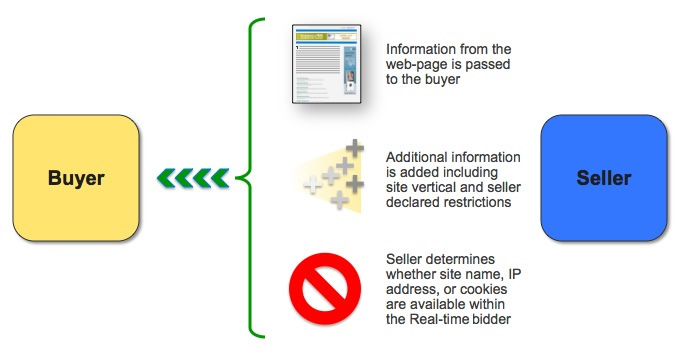En esta guía, se proporciona una descripción general de los conceptos de ofertas en tiempo real (RTB) necesarios para escribir aplicaciones de ofertantes que puedan participar en las ofertas en tiempo real de Authorized Buyers.
Conceptos básicos
Una aplicación de ofertante puede comunicarse con Google a través de uno de los protocolos de RTB compatibles. Una solicitud de oferta enviada a una aplicación proporciona contexto sobre al menos una oportunidad de anuncio para que el ofertante pueda determinar la creatividad y el importe de la oferta óptimos (si corresponde) para cada impresión. Un ofertante puede responder con una respuesta de oferta para realizar al menos una oferta y especificar la creatividad que se colocará para las oportunidades de anuncios enviadas en la solicitud.

La siguiente situación es una posible interacción entre una aplicación de ofertante y Authorized Buyers:
- Google envía a la aplicación del ofertante una solicitud de oferta que describe una impresión que se está subastando. La cuenta del ofertante está configurada para usar OpenRTB en formato Protobuf, por lo que la solicitud llega como un
BidRequestserializado, como se muestra en openrtb.proto. Para saber cómo debe interpretar tu aplicación la solicitud de oferta, consulta Cómo procesar la solicitud. -
La aplicación del ofertante analiza la solicitud y aplica su lógica de ofertas para crear un objeto
BidResponseque incluye una oferta y una creatividad para la oportunidad de anuncio. Luego, la aplicación serializa la respuesta a la oferta y la envía a Google. Para obtener información sobre cómo tu aplicación debe crear y devolver una respuesta de oferta, consulta Cómo compilar la respuesta. -
Se recibe la respuesta a la oferta y su oferta ingresa en la subasta abierta, en la que gana la impresión porque es la oferta más alta. Como resultado, se coloca la creatividad especificada en la respuesta.
Selecciona un protocolo
El protocolo de licitación en tiempo real especifica los indicadores que tu aplicación puede usar para evaluar cada impresión enviada en una solicitud y ofertar por ella, así como la forma de crear una respuesta. Existen dos formas de modificar el protocolo asociado a tu aplicación de ofertante:
- Comunícate con tu administrador técnico de cuentas para cambiarlo de forma manual.
- Usa la API de REST de Authorized Buyers para cambiarlo de forma programática.
Protocolos admitidos
Authorized Buyers admite dos protocolos de RTB:
- OpenRTB (Protobuf)
Es una implementación de la especificación de OpenRTB que usa Protobuf.
- OpenRTB (JSON)
Es una implementación de la especificación de OpenRTB que usa JSON.
Acerca de los búferes de protocolo
Protobuf es un formato de código abierto para representar y serializar información estructurada.
Si quieres usar OpenRTB Protobuf, debes instalar el compilador de protocolos y el tiempo de ejecución de Protobuf para el lenguaje que elijas. Luego, puedes descargar los archivos .proto que deseas usar y ejecutar el compilador para generar una biblioteca que pueda serializar o deserializar mensajes definidos en el archivo .proto, como BidRequest o BidResponse. En esta referencia de Protobuf, se muestra cómo hacerlo en varios lenguajes.
Actualizaciones de protocolos
Los protocolos de RTB se modificarán a medida que Google agregue funciones nuevas y descarte otras. Los cambios se anunciarán mucho antes de que entren en vigencia, lo que debería darte tiempo suficiente para quitar las dependencias que tu aplicación pueda tener en los campos que se programaron para su baja. Para obtener más información sobre el manejo de campos obsoletos, consulta Cómo adaptarse a la obsolescencia de los campos de BidRequest.
Próximos pasos
En el siguiente contenido, se proporcionan más detalles sobre los conceptos de las ofertas en tiempo real:
- Procesa la solicitud: Cómo analizar e interpretar los indicadores que se encuentran en la mayoría de las solicitudes de ofertas
- Cómo compilar la respuesta: Cómo compilar una respuesta a la oferta y los campos que se suelen especificar en la respuesta
- Guía de OpenRTB: Referencia para la implementación de la especificación de OpenRTB en Authorized Buyers, además de las extensiones específicas de Authorized Buyers Detalla los casos extremos y las limitaciones específicos de esta implementación, y, además, identifica los campos equivalentes en el protocolo de Google.
- Requisitos para la publicación de anuncios de terceros: Define las políticas que deben satisfacer los postores para usar diversos formatos de anuncios, así como las especificaciones técnicas de esos formatos.
- Segmentación previa: Cómo configurar tu aplicación de ofertante para que solo reciba impresiones que coincidan con tus criterios de segmentación
- Cookie Matching: Es una referencia al servicio de correlación de cookies y a otros servicios relacionados que se usan para el remarketing.
- Restricciones de latencia y peering: Detalles sobre las ubicaciones de intercambio y cómo reducir la latencia, por ejemplo, a través del peering.
- Cómo probar y lanzar tu aplicación: Detalles para comenzar a probar tu aplicación de ofertante con el tráfico que envía Google a gran escala.

